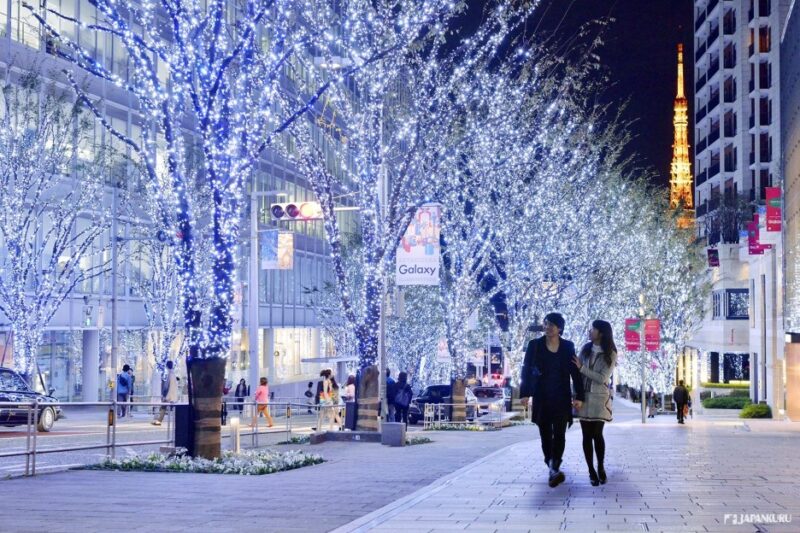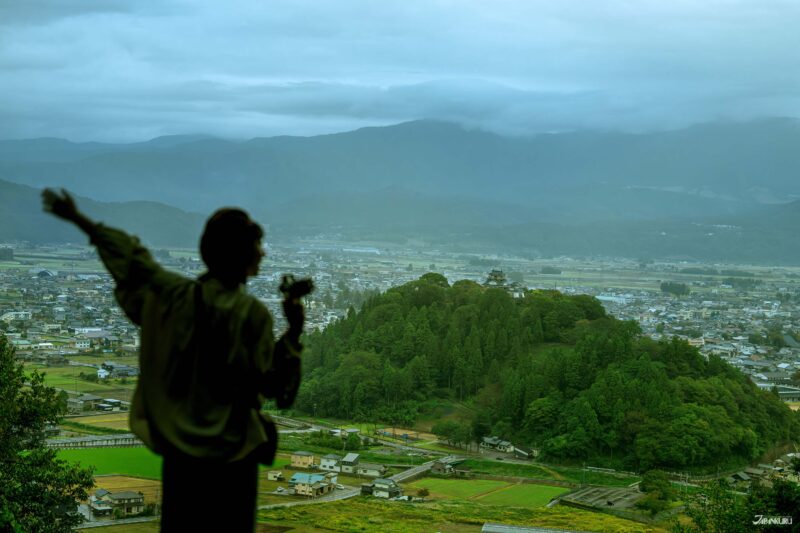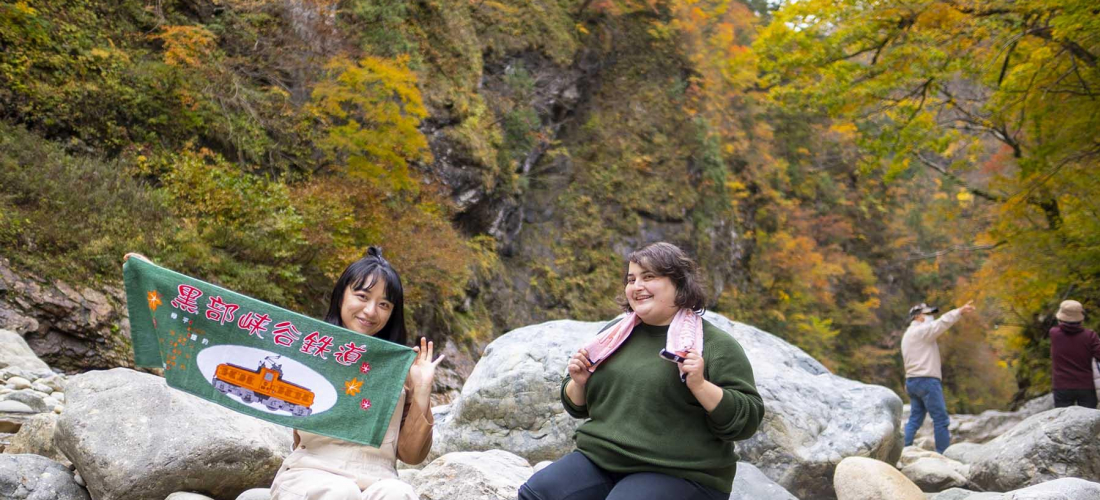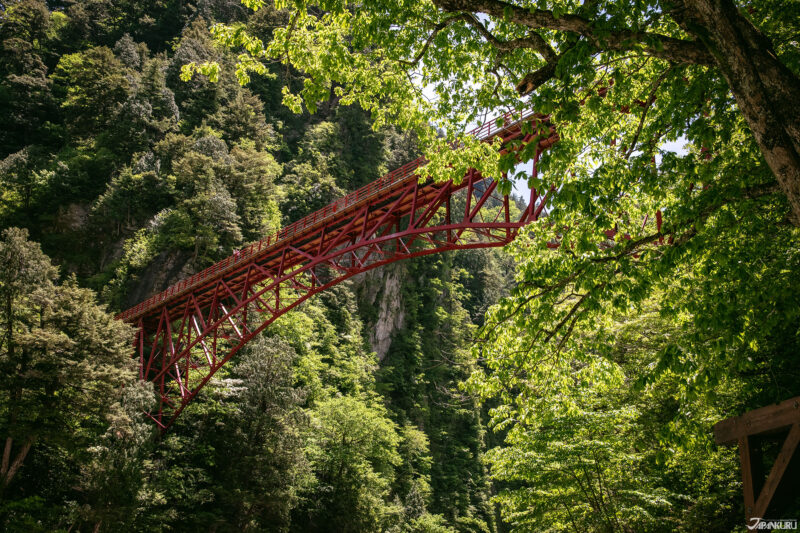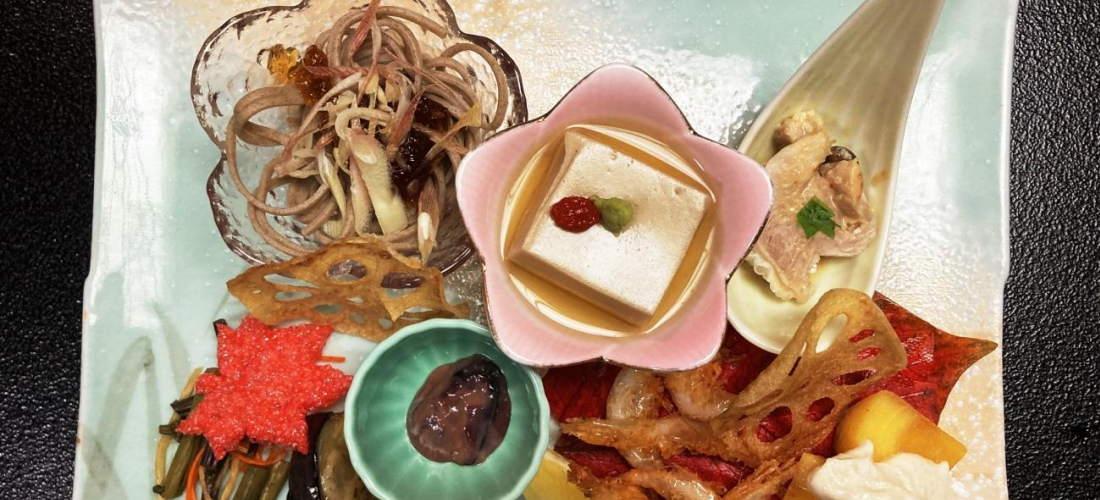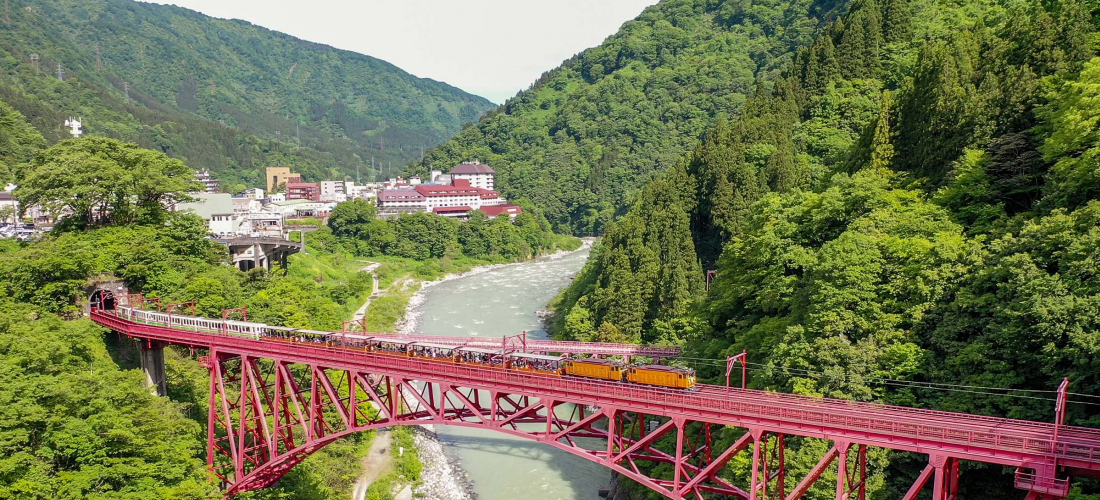
CONTENTS
Toyama Prefecture might be known among international travelers for its impressive walls of snow found in the “Snow Corridor,” but tucked just a few miles away are many more hidden gems in the surrounding area. The nearby bay provides fresh seafood Toyama is known for, and the Unazuki Onsen area inside the Kurobe River Valley is full of gorges, perfect in the summer for active adventures like rafting and canyoning. “Onsen” means hot spring in Japanese, and Unazuki Onsen is of course dotted with its namesake, full of luxe hot springs. After testing your endurance in the river rapids, Kurobe offers the chance to take a reviving soak, admire the scenery on the Torokko Train, and then sample all of the local specialty cuisine, before drifting off to the sounds of the mountains.
Born between the sea and the mountains, read on to find out about all Kurobe has to offer!
Kurobe Gorge Guide: Why This Toyama Canyon Belongs on Your Japan Itinerary
Kurobe City (黒部市) has found a little fame from the high walls of snow popular with visitors looking for some good Instagram shots, but travelers who admire the snow and then get out of town don’t even know what they’re missing.
Toyama is in the Chubu Region of Japan, in the central part of Japan’s main island of Honshu, with the western border taken up by the coast of the Sea of Japan. We can thank the sea, and especially Toyama Bay, for the abundant fresh seafood found around the prefecture! But the Unazuki Onsen area also provides Kurobe with gloriously steamy hot springs, bursting forth from the mountain crags. All this geological variation makes for deep ravines, and the rivers running through those are a great place to try canyoning. Take the Kurobe Gorge Railway’s Torokko Train around the area to explore, and we’re pretty sure you’ll be pleasantly surprised by how much fun this unassuming region can be.
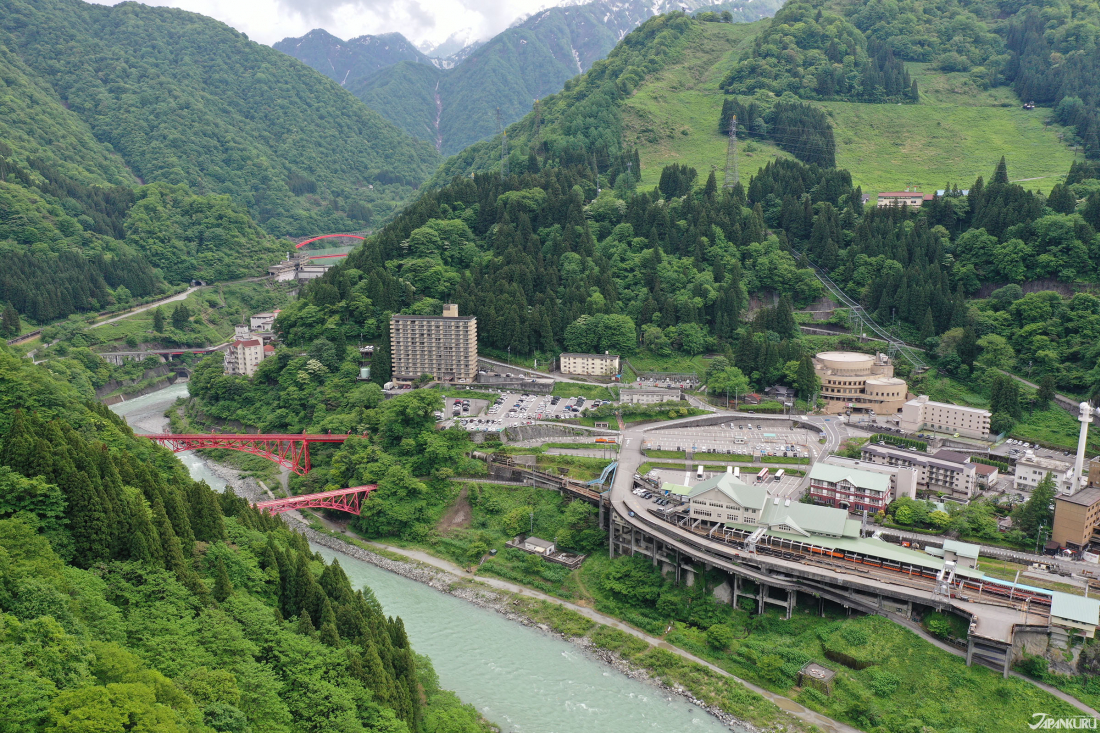
How to Get to Unazuki Onsen (Kurobe Gorge): Trains, Times & Costs
Unless you’re already at the Toyama Airport, the easiest way to get to Kurobe is probably via shinkansen (a.k.a. bullet train), which will get you there in no time.

Taking the Hokuriku Shinkansen Line to Kurobe-Unazuki Onsen Station (黒部宇奈月温泉駅)
| From Tokyo Station | 2 hours 20 minutes | 11,860 yen |
| From Kanazawa Station | 35 minutes | 4,020 yen |
| From Toyama Station | 12 minutes | 2,940 yen |
From the shinkansen station you have to take one more train ride to get to the main Unazuki Onsen area. Cross the street to get to Shin-Kurobe Station on the Toyama Chihou Railway line, and take that for another 30 minutes or so (round-trip discount ticket: 1,100 yen). The way over is quite picturesque, including the retro train itself, so enjoy the ride! You’ll eventually want to get off at Unazukionsen Station.
(Note: it’s a bit confusing, but the shinkansen station where you transfer is “Kurobe-Unazuki Onsen Station”, and your final destination is just “Unazukionsen Station”.)
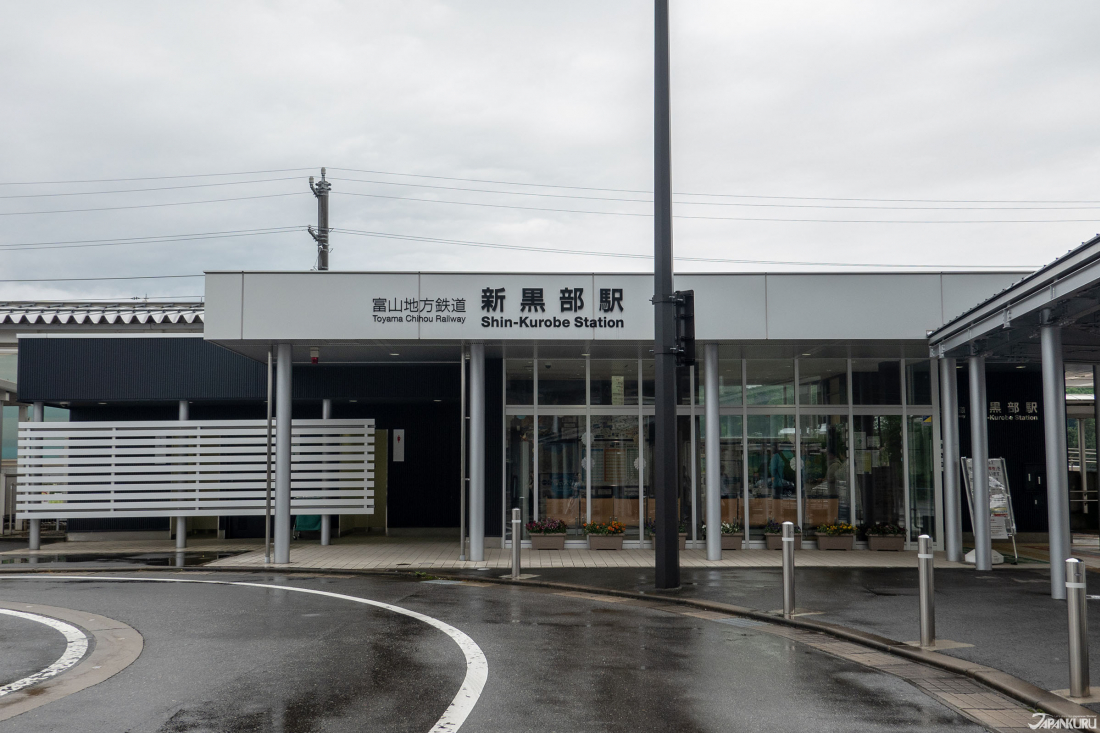
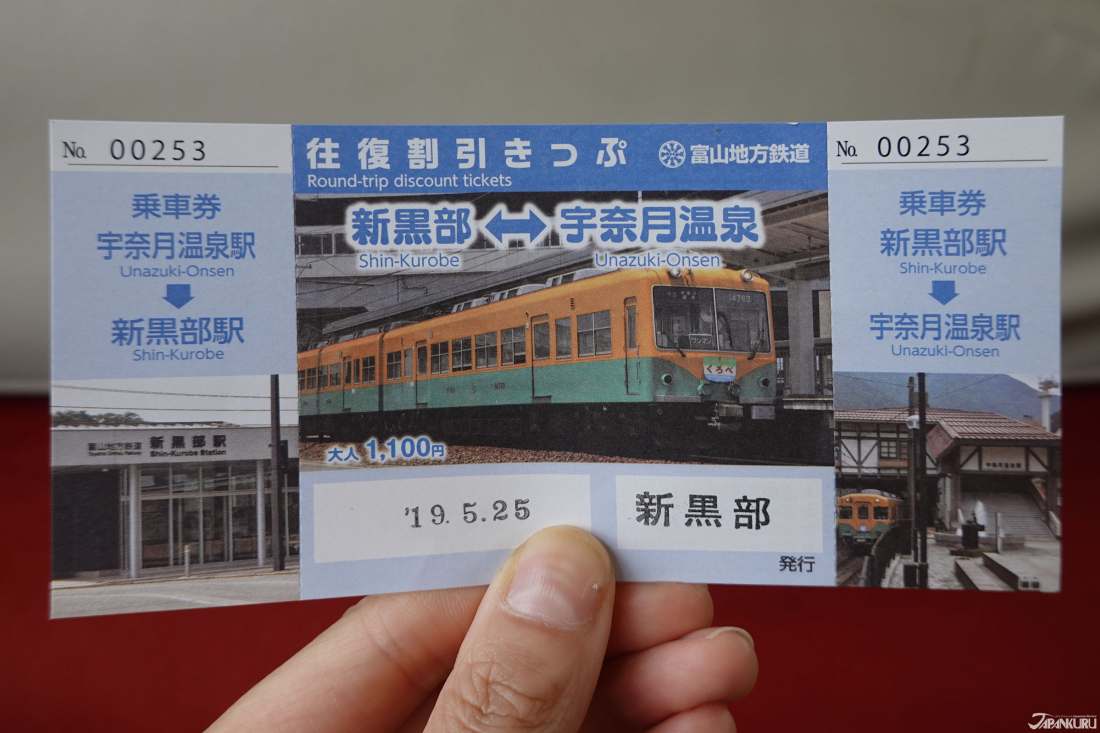

From Toyama International Airport, the easiest route is just to take the airport bus to Toyama Station, and then go the shinkansen route from there. The whole trip should cost you about 3,370 yen, although all of these prices are subject to change.
To Truly Enjoy the Village of Unazuki Onsen, Go for a Ryokan
When you’re spending time in a little Japanese town like this, it’s the perfect opportunity to stay at a local ryokan-style traditional hotel. Ryokan are set up to help you make the most of the nearby hot springs, local gourmet specialties, and beautiful views!
Unazuki Onsen Togen Ryokan

During our visit, we lived it up by staying the night at Togen Ryokan, a ryokan set up for convenient access when touring Unazuki Onsen. Not wanting to waste any chances to enjoy Kurobe to the fullest, we took advantage of the private open-air baths available for rent, and the premium kaiseki ryori multi-course meals on offer. It was lots of fun getting to try all the local specialties in Toyama; we wholeheartedly recommend it.
If you’d like to see for yourself what Togen Ryokan is like, they have a variety of rooms available. Some come with standard beds, and others are like this Japanese-style tatami room, made for families or groups, with lots of places to sit and a great view of the river. If you’re still doubting the comfort of these rooms, just know that most have fragrant tatami floors, 70% of them come equipped with state-of-the-art massage chairs, and all of them have yukata available in a few different sizes, for relaxing in around the hotel. We were certainly pretty comfortable!
Unazuki Onsen Togen Ryokan
Address: 22-1 Unazuki Onsen, Kurobe City, Toyama
Phone: 81-765-62-1131
Check-in/Check-out: 15:00/10:00
Official Website (en)
Why Choose a Ryokan? Reason #1:
Enjoy your own private hot spring bath!
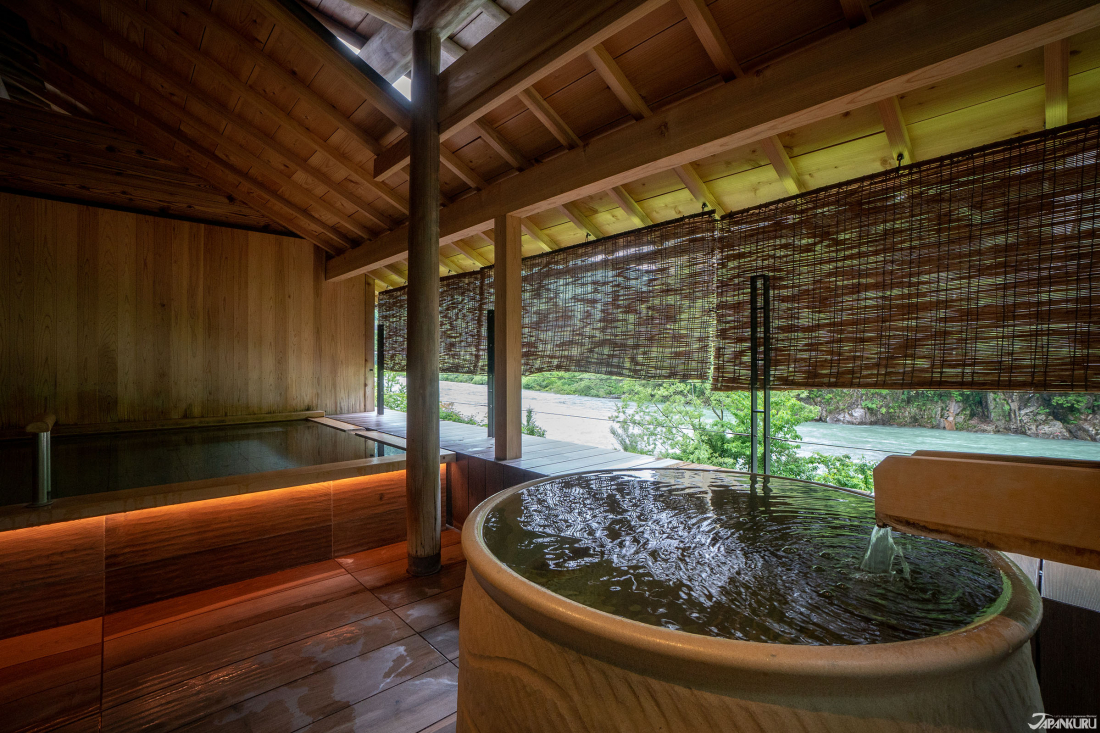
Ryokans often offer what are called “kashikiri onsen” (貸切温泉), literally hot springs for rent, where you can lounge in the luxurious hot water away from the rest of the guests. If bathing with strangers still makes you nervous (although you really shouldn’t worry about it in Japan), or you just want to spend some nice one-on-one time with a special someone, make sure you reserve your time slot for the kashikiri onsen as soon as possible. They’re also a good option for those of us with very obvious and hard-to-conceal tattoos, since tattoos are often frowned upon (or even banned) at Japanese onsen.
Togen Ryokan has three of these private baths available to rent, all for no additional charge. The water here is mildly alkaline, which they say makes for beautiful skin post-bath! Just call the front desk to check availability, then pick up the keys and enjoy your soak.
(Available 15:00 – 22:00/7:00 – 10:00, 40 minutes at a time.)

If you want to really stretch out in a private bath, or you just want to rent one for up to eight people, check out Togen Ryokan’s larger open-air rental bath. This one requires a fee, 2,000 yen for 45 minutes, but hey, if not now then when? Treat yourself. To make sure you can reserve a spot, make your reservation at check-in.
(Available 15:30 – 23:15/6:00 – 9:45. 2,000 yen plus tax for 45 minutes. )
Why Choose a Ryokan? Reason #2:
Enjoy… the public bath!
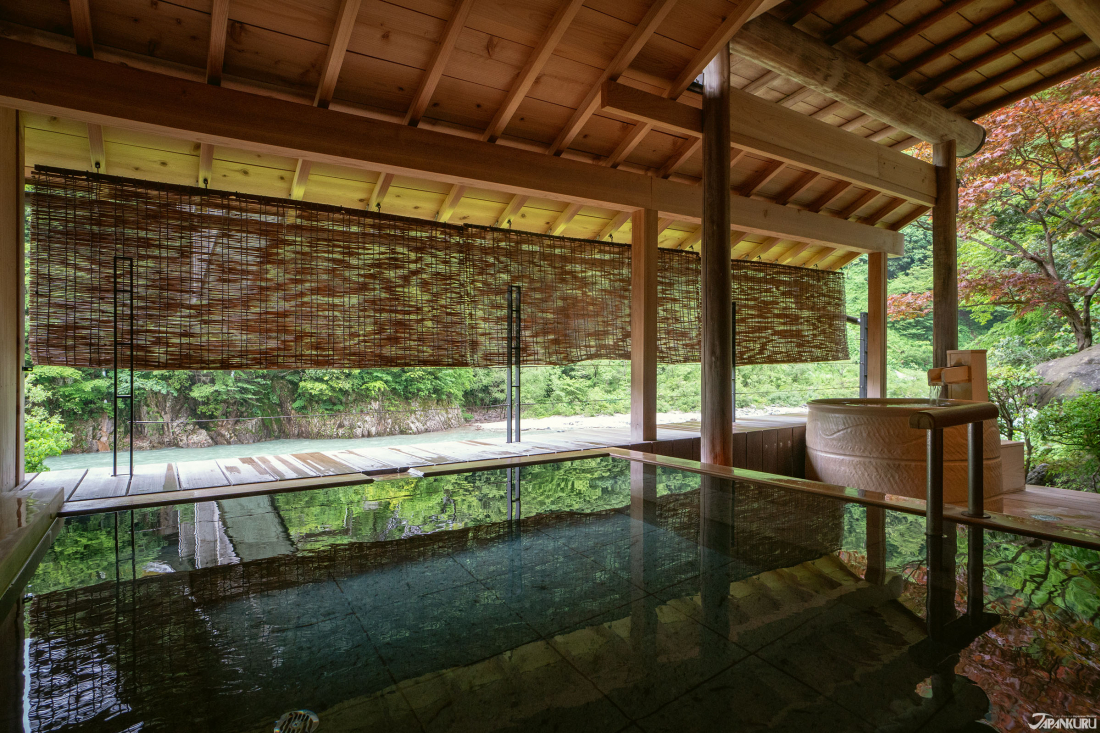
If you want the true onsen experience, then you’ve got to spend some time in the public baths! Visiting a ryokan with hot spring facilities means you’re in for a pretty spectacular bathtime experience. Togen Ryokan has open-air baths built from hinoki cypress, and the warm wood gives off a pleasant aroma. Since the ryokan is right next to the river, you can watch the cold Kurobe River water rush by while feeling the hot spring water gently lap up around you.
In addition, there is also a boulder bath (岩風呂) and a special granite bath (御影石風呂) indoors.
(15:00 – 23:30 – rock bath open to men, granite bath open to women.
24:00 – 10:00 – rock bath open to women, granite bath open to men.)
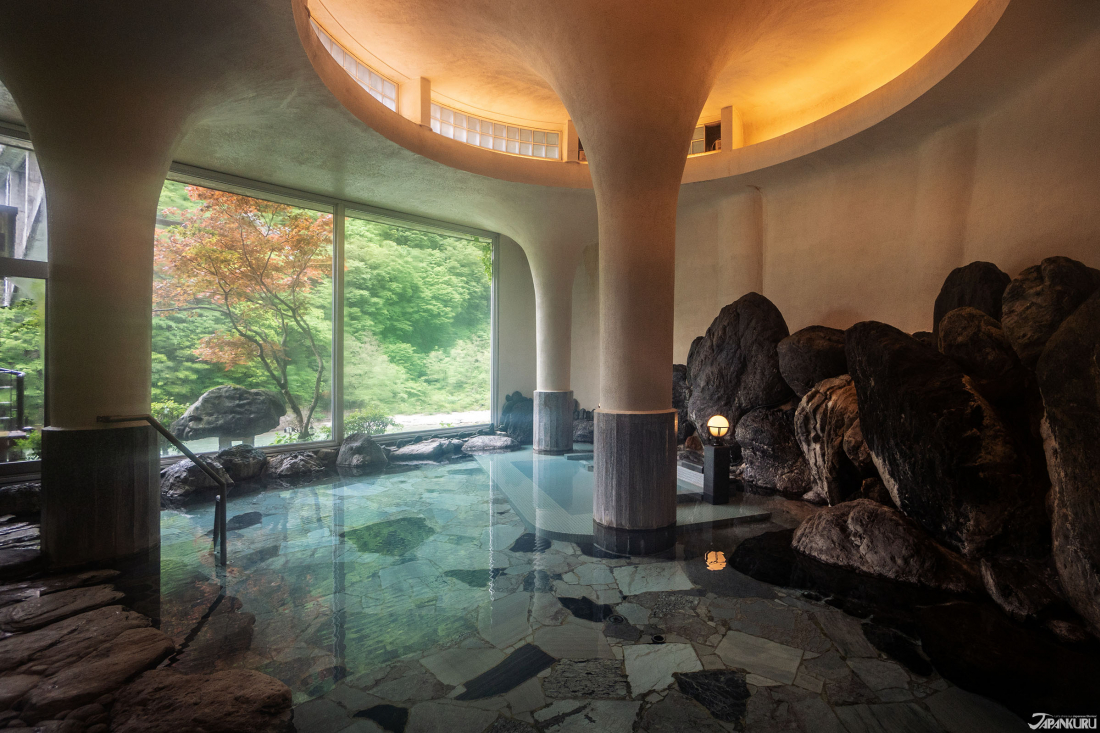
The bath is lined with smooth stone, and the far corner has headrests letting you comfortably lie down in the water.

The ante-room provides all kinds of amenities, from nice face creams to blow-dryers. Just grab the towel from your room and you’re ready to go.
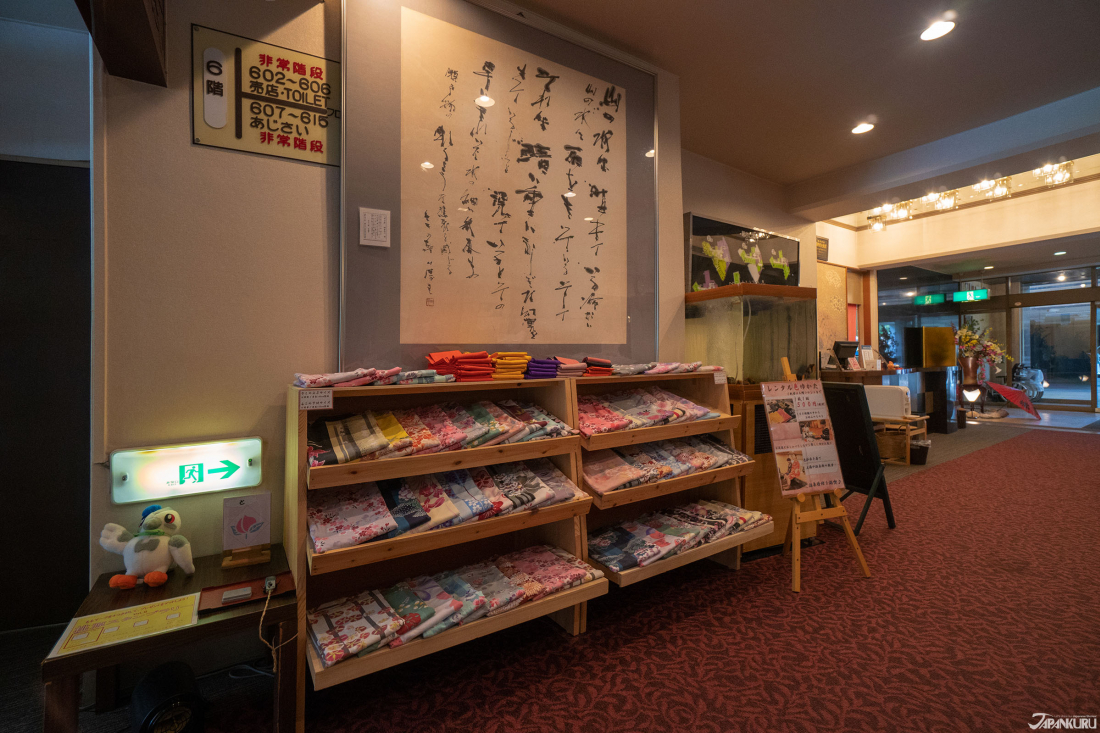
If you want to wear a colorful yukata, a little fancier than the ones provided for free, you can rent one for 500 yen. Once you’re fresh and clean and positively glowing from the hot spring water, do a yukata photoshoot!
Why Choose a Ryokan? Reason #3:
Indulge in a kaiseki multi-course meal.

Ryokan are known for offering really delicious multi-course traditional Japanese meals, so this ryokan staple is a great way to try some of Toyama Prefecture’s impressive agricultural specialties. We tried firefly squid (ホタルイカ), Toyama’s local variety of high-quality wagyu called “himi-gyu” (氷見牛), and very fresh abalone.

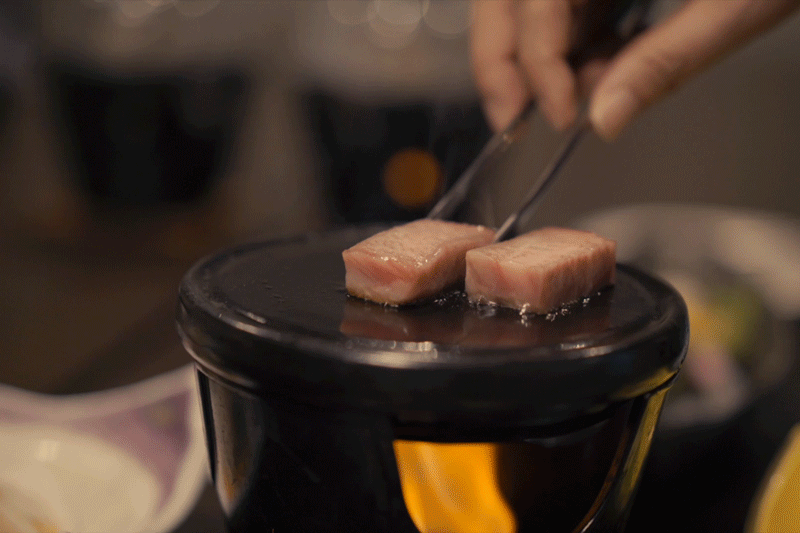
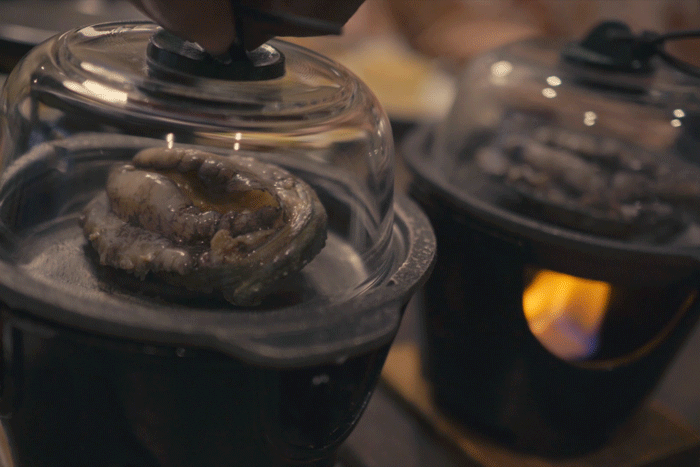
Top Things to Do Around Kurobe Gorge & Unazuki Onsen
Rich in clear water, fresh mountain air, and all the scenic geography to go with them, what’s the best way to explore all that Kurobe has to offer? Let us fill you in on how to check it all out.

Sightseeing in Kurobe: ① Canyoning in Kurobe Gorge
Blessed with deep canyons and hearty rivers, Kurobe has the perfect conditions for pushing yourself to the limits. Our recommendation? Canyoning. It’s an exhilarating way to explore the natural landscape.
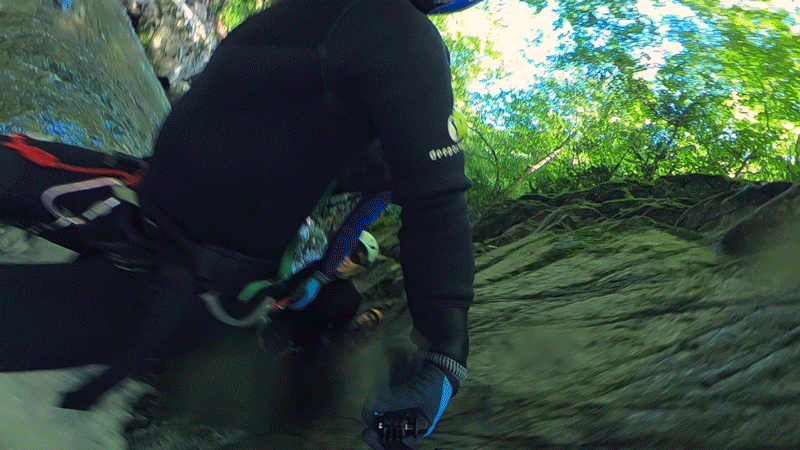
Canyoning is something of an extreme sport, so you have to be accompanied by an expert. Canyoning tours are offered locally by J-WET Adventures, where the pros will coach you through the experience and make sure everyone has a good time. When you’re not entirely confident in your abilities, they’ll lend a helping hand and keep you safe! Read on to find out how to go canyoning yourself.
(Available from early June through to the end of October.)
1. Choose a tour course. (Find your options here.)
– 3 Hour Course: 13+ y.o., 10,000 yen per person.
– 6 Hour Course: 20+ y.o., 15,000 yen per person.
2. Book your tour online, or over the phone.
– From the homepage, email them with your details.
– Make phone reservations in English or Japanese.
3. Confirm your reservation completion by e-mail.
4. Meet your J-WET Adventures guides at Nakajima Ski Center.
– If you’re staying within a five or ten minute drive, they offer a shuttle service. Just ask!
5. Pay for your tour, get ready to go canyoning, and then go for it!
– Don’t forget to bring your bathing suit or clothes you don’t mind soaking through, along with a towel, and anything else they recommend.
– If you use contacts, make sure to bring a pair of goggles.
Sightseeing in Kurobe: ② Unazuki Dam Views
With so much water rushing along the Kurobe River, the dam was built as a hydroelectric power plant, to take advantage of the river’s energy. Unazuki Dam took years to build, and after a while the construction workers started to settle down nearby, breathing life into the Unazuki Onsen area. You could say that the town is now there thanks to the dam!
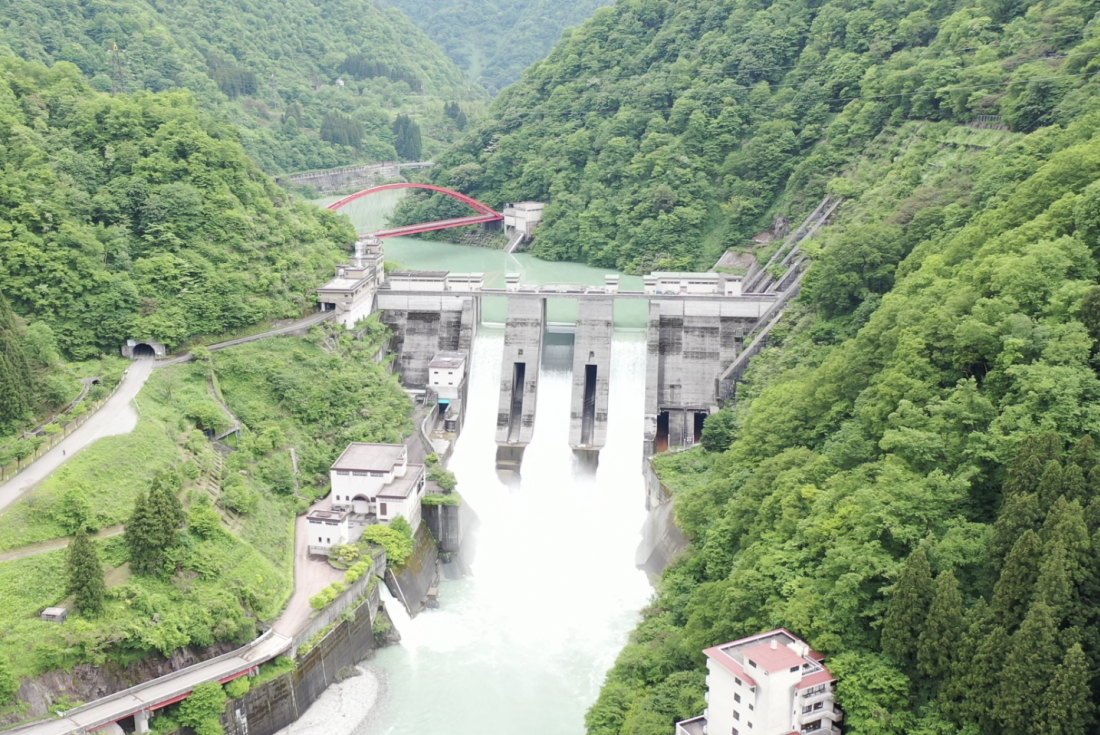
Walking to see the impressive dam is a 2.7 km (1.7 mile) walk from Unazukionsen Station (Google Maps), but you can also skip the trek and get a great view right from your seat on the Torokko Train that passes by.
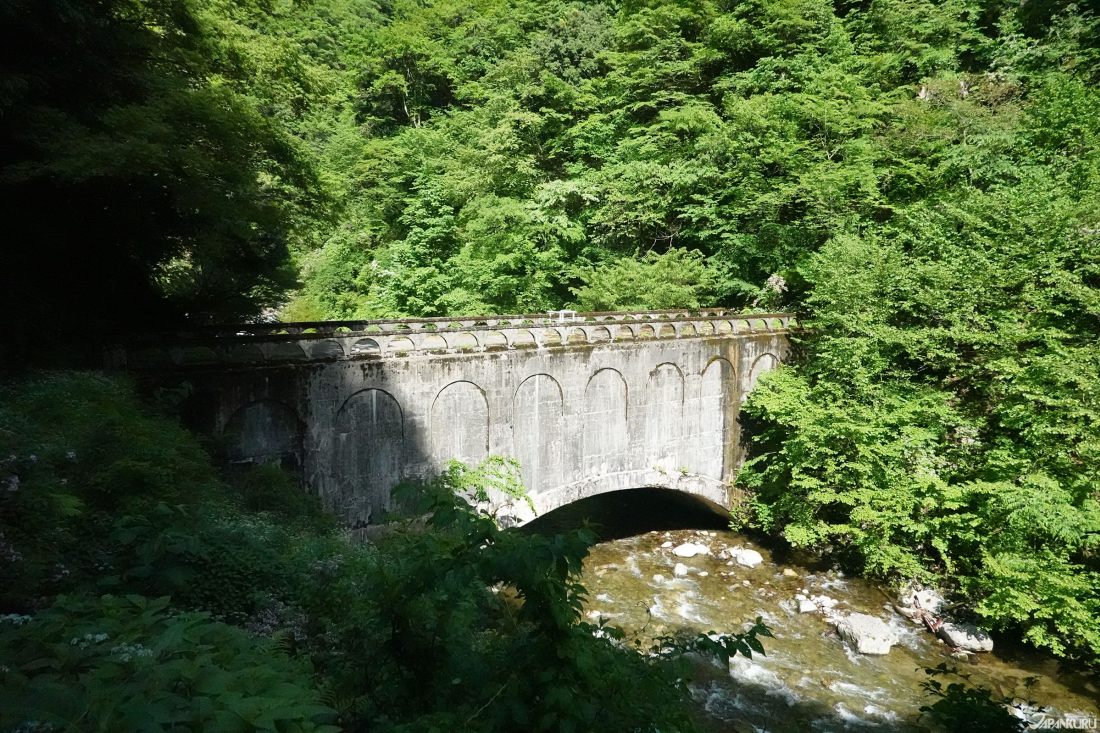
Unazuki Onsen is also home to an aqueduct bridge, designed 90 years ago by the famous Japanese architect Bunzo Yamaguchi.
Sightseeing in Kurobe: ③ Kurobe Gorge Railway’s Torokko Train
When admiring the scenic views of Kurobe, you can’t miss the local Torokko Train. It gives you access to all the spots in Kurobe that you can’t even drive to, letting you see the hidden gems of the area.
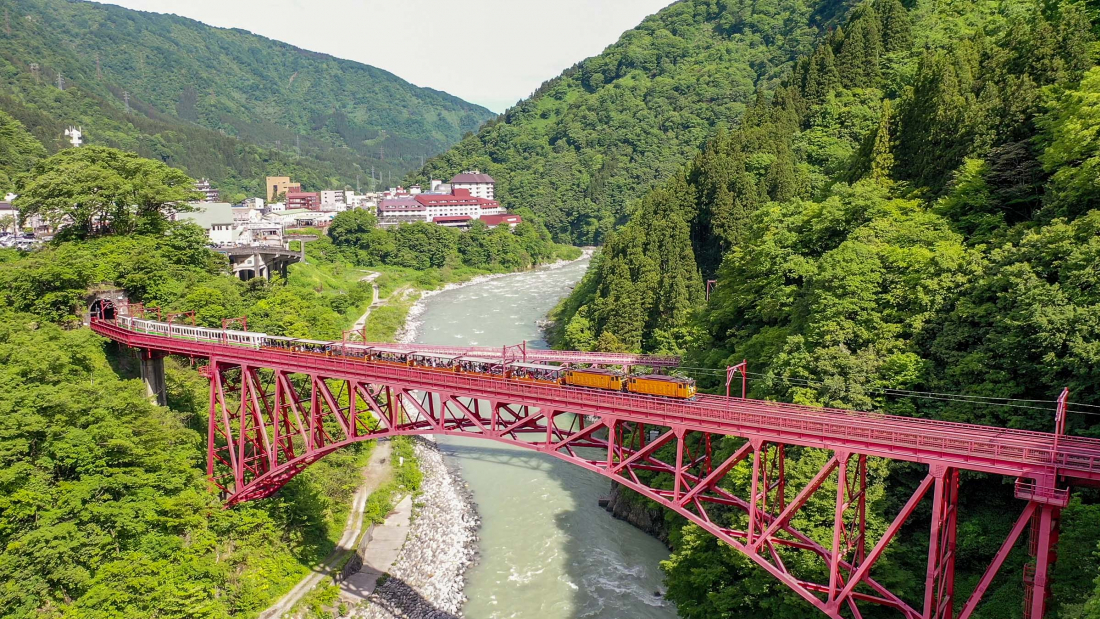
This railway was built in 1923, and was originally used to carry cargo around the area, but opened for general passenger use after 30 years in 1953. The history of the shift from freight train to leisure railway is actually kind of an interesting story. While working on dam construction along the river, workers would ride the railway with the cargo to get to the construction sites. Looking around at the scenery while they rode, these construction workers happened to lay eyes on some particularly picturesque views, noting how beautiful the lay of the land was. These comments made their way to the wealthier residents of Kurobe, eventually becoming a topic of local gossip. The original cargo train was absolutely not set up for passengers, making it fairly dangerous, but the rumors of the scenery’s beauty rose to such a fever pitch that some of the upper class started to say “I don’t care if I die, I just have to see the scenery once in my life!” From that point, the area became a sightseeing destination. With such strong desire to gain access to the Torokko Train, starting so many years ago, it seems like the railway has always been the best way to view the local scenery.

Route Map from Unazuki Station to Keyakidaira Station
The Torokko Train runs a set number of times each day, so it’s a good idea to think about how you’re going to allot your time before you hop on (check the official timetable). The time between each of the stations is about 20 to 30 minutes, and the price of tickets depends on which kind of car you ride in. We recommend riding in one of the open-air passenger cars, where a one-way ticket from Unazuki Station to Keyakidaira Station will run you 1,980 yen (or 990 yen for children).
A straight shot from Unazuki Station to Keyakidaira Station lasts about an hour and ten minutes, but you can get off at each of the stations in between, and make a whole sightseeing day trip out of it. Let us tell you about some of the most beautiful natural scenery and onsen, and the best photo spots, you’ll find at each of the Torokko Train’s stations.
*Due to damage from the 2024 Noto Peninsula Earthquake, a portion of the Torokko Train route is currently out of service. While the railway works to restore service, passengers can still enjoy the ride from Unazuki Station as far as Nekomata Station.
① Unazuki Station (宇奈月駅)
Before you even get on the train, there are some cool spots around Unazuki Station!
Just a five-minute walk from the station is the Yamabiko Observation Deck, where you can see the orange train and red bridge gleam in the sunlight, as the train passes through some lovely natural scenery. (If you’re carrying around any suitcases or heavy luggage, there are some lockers at the train station that we recommend you use to stash your bags first thing.)

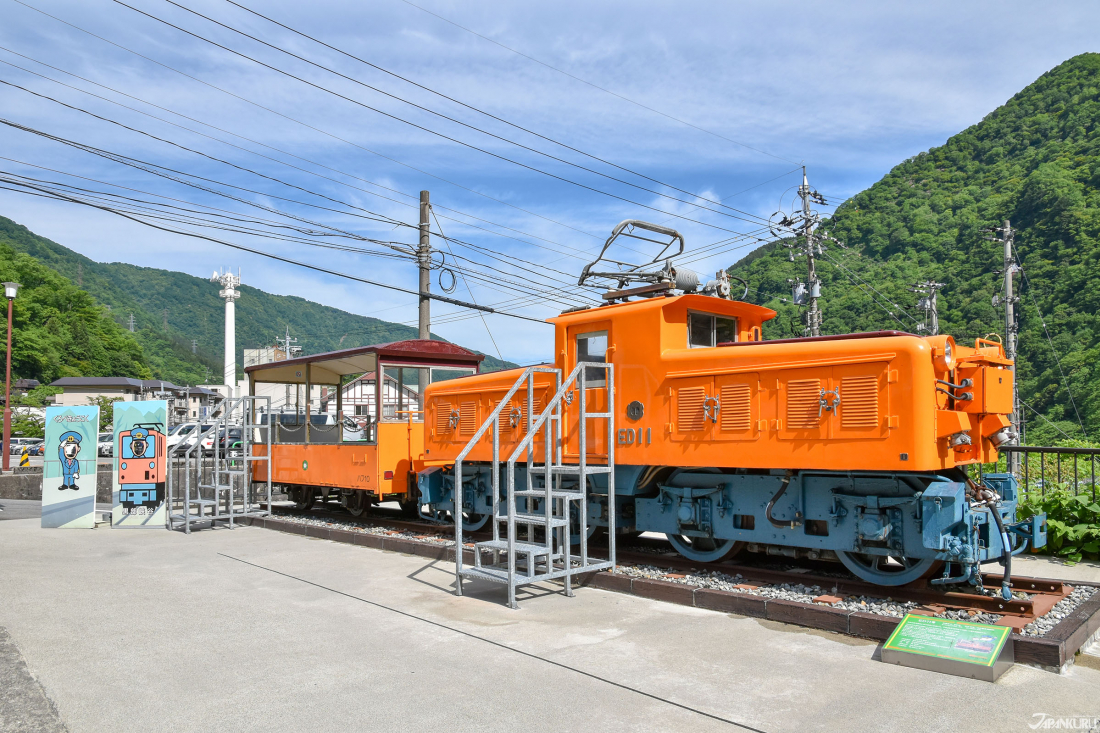
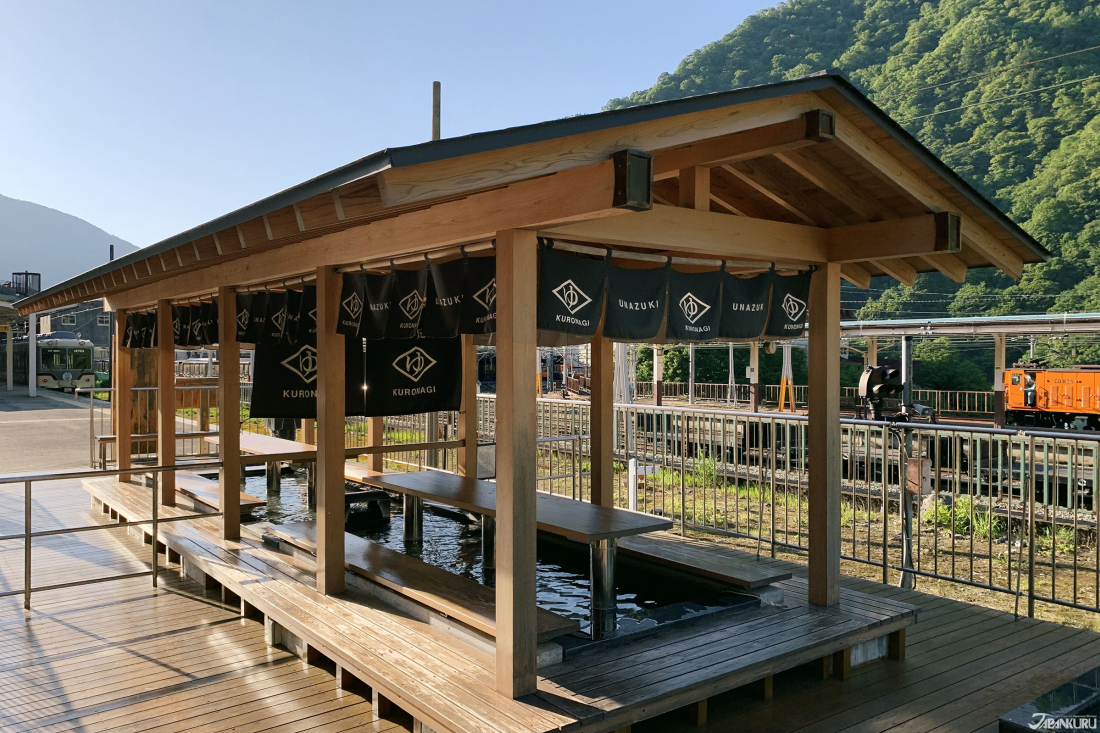
② Kuronagi Station (黒薙駅)
As we mentioned above, the Unazuki Onsen area is of course known for its onsen, or hot springs. Water reaching temperatures above 90°C (194°F) gush forth from crevices in the ground. Near Kuronagi Station, you’ll find “Kuronagi Onsen” where you can soak in the steaming water while watching the river cut its way through the natural scenery. (Near Kuronagi Station you’ll also find Atobiki Bridge, which crosses Kurobe Gorge at its deepest and steepest point.)

Kuronagi Onsen, an outdoor open-air hot spring.
One thing to know about Kuronagi Onsen: it’s a mixed-gender hot spring! You’re totally welcome to wear a swimsuit in the water, if you feel more comfortable that way, but there will also be people in the nude there. If you’d prefer separate-gender hot springs, there are some indoors at the small ryokan next door.
(Kuronagi Onsen day pass: adults 700 yen, children 300 yen.)


Atobiki Bridge (後曳橋), seen over the seemingly bottomless valley.
③ Kanetsuri Station (鐘釣駅)
Near Kanetsuri Station you’ll find a river beach where you can dip into the running water and hang out on the sand, so it’s especially worth a stop in the summer. Along the river’s edge there are even spots where onsen water bubbles up, meaning you can surround one with some rocks and make yourself your own little private hot spring! (This area is just for local lodgers after 16:00.)
This station is also where you’ll find the Kurobe Mannen Yuki (万年雪), or “perpetual snow” bank.
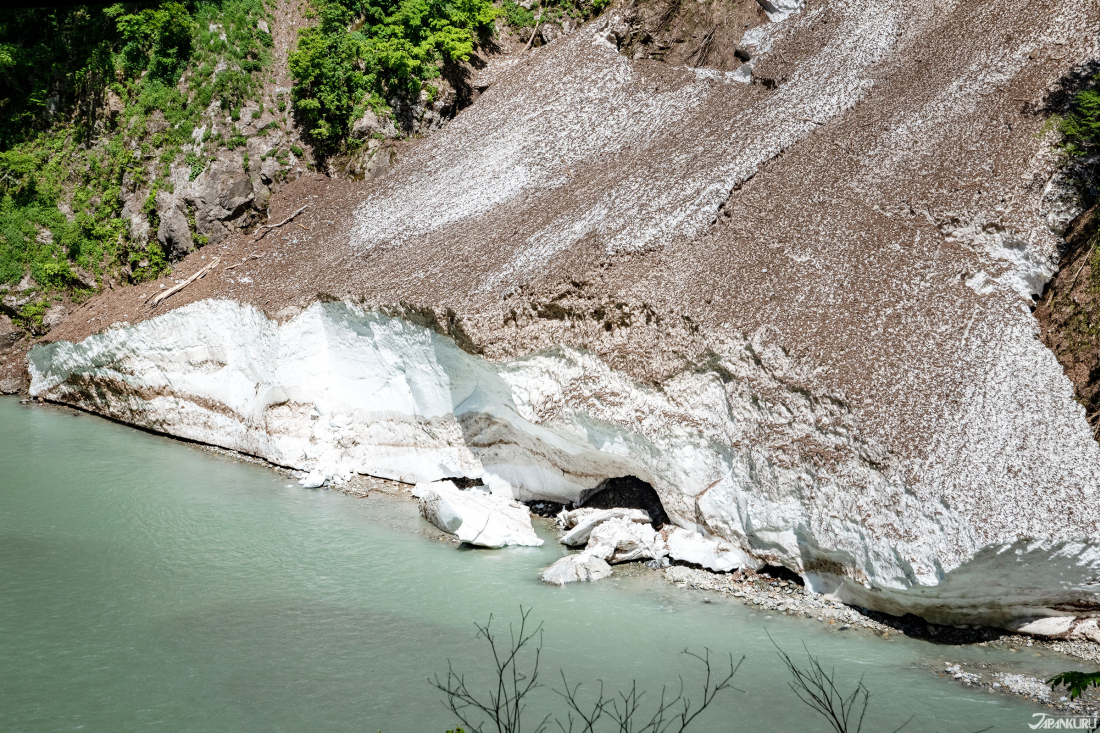
Kurobe’s perpetual snow… also known as the “tiramisu”!
This time around, the river had flooded from heavy rain and water levels were too high for us to explore the river’s beach. Luckily, we still got to see the Kurobe Mannen Yuki, a snowbank that sticks around even through the heat of summer. The dust and debris that falls onto the snowbank really does look a bit like cocoa powder, doesn’t it? Stare long enough, and it starts to look good enough to eat… can you imagine a real tiramisu that big?
④ Keyakidaira Station (欅平駅)
Keyakidaira Station is the biggest of the stations inside the gorge, and inside the station building you can grab a bite to eat while you admire the view, and buy some souvenirs. All around the area are a number of spots with interesting views, and interesting names, making it a good place to take some fun pictures to remember the day by!
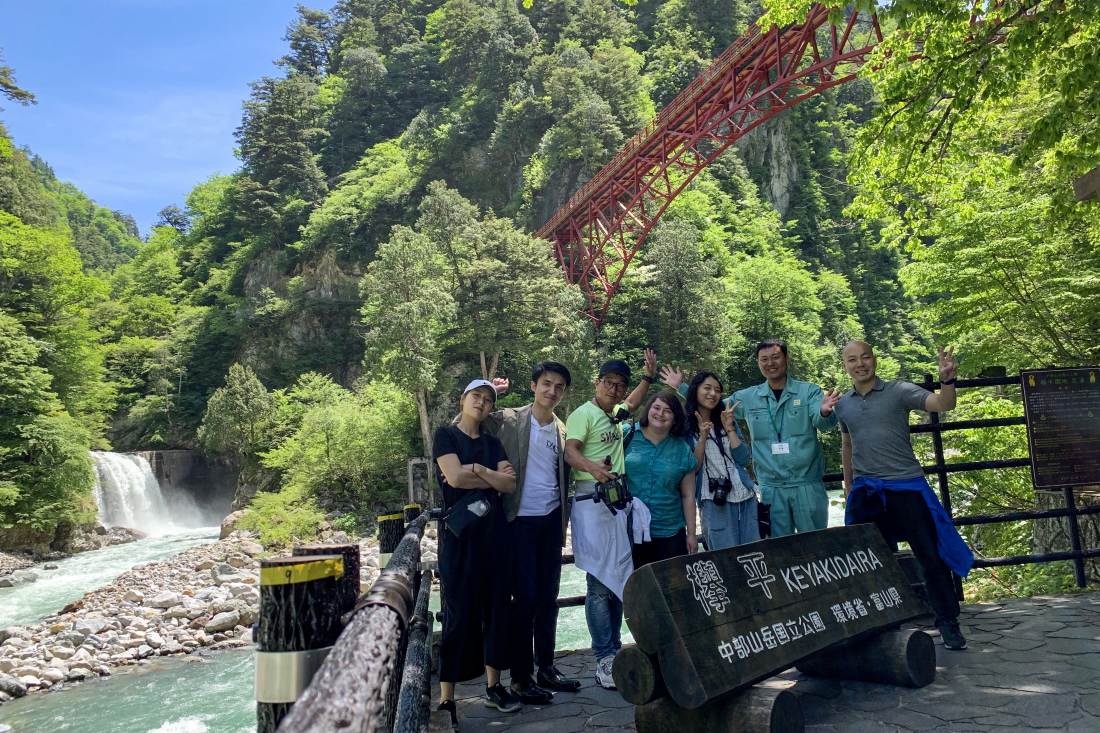
#keyakidaira
Our recommendation for a group photo spot is definitely right here! With the invigorating scenery of the gorge and Okukane Bridge in the background, we challenge you to take a truly insta-worthy shot.

#sarutobikyo
This spot’s name, Sarutobikyo (猿飛峡) literally means “monkey jumping gorge.” The distance between the two sides of the canyon are so close here, people have long believed that it’s where monkeys would jump across. There’s an observation platform right nearby.
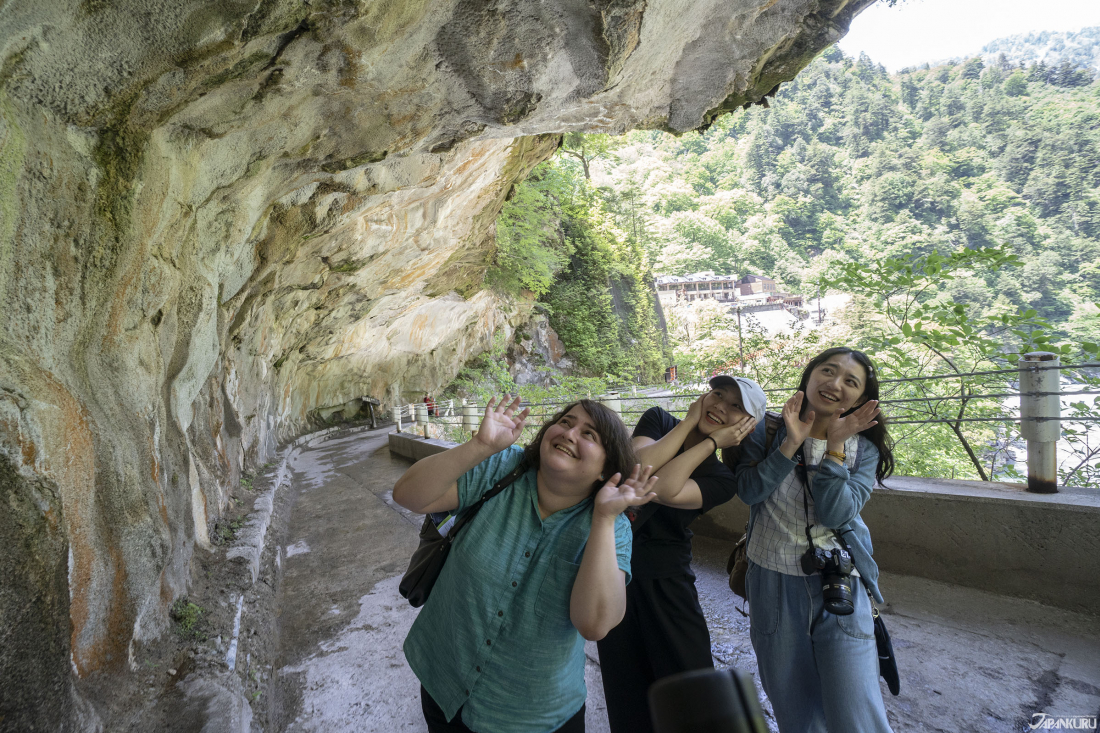
#hitokuiiwa
This craggy overhang looks a little like an open mouth, making it feel like you might just get eaten up when you walk through. That’s where the name comes from, since “hitokuiiwa” (人喰岩) literally means “people-eating crag.”

#okukanebridge
The Unazuki Onsen area has three kinds of bridges: bridges for transportation, bridges for hydroelectric power, and then bridges for pedestrians. Okukane Bridge (奥鐘橋) is the third variety, and it’s there just for you to leisurely walk its length and admire the beautiful scenery of Kurobe Gorge.
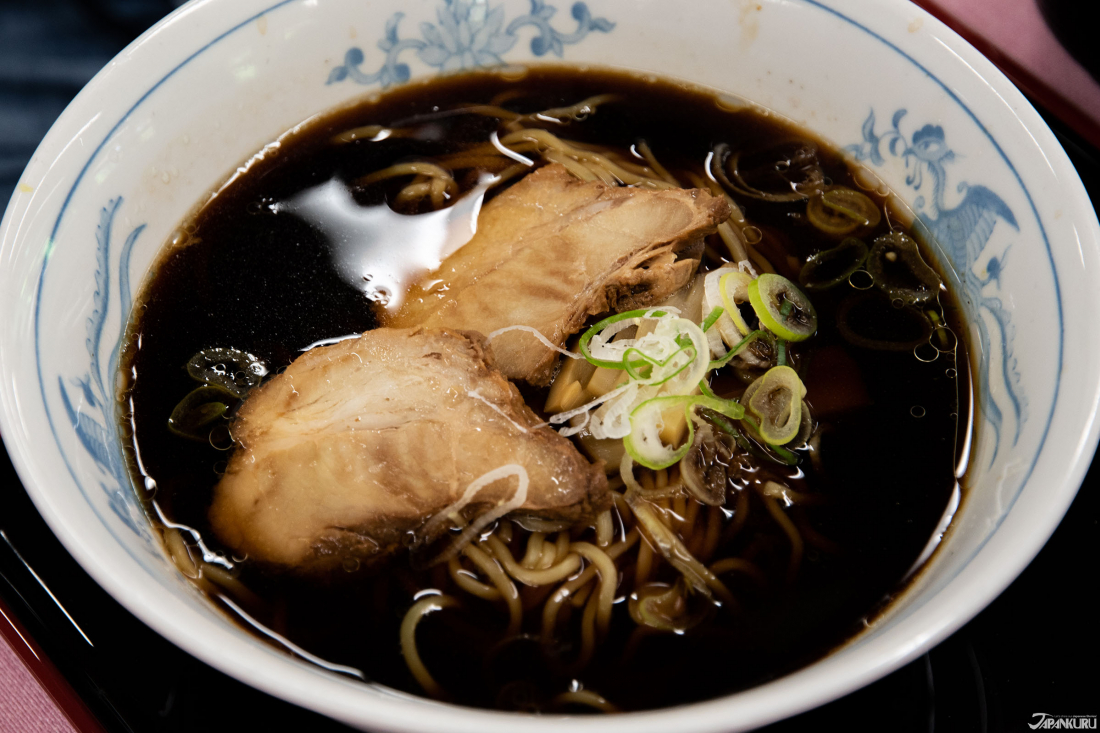
#dinnerwithaview
While you’re more likely to eat lunch than dinner at Keyakidaira Station’s food court, you’ll still be able to see the scenery while you try out the local specialty of “black ramen.” After eating, head to the roof and take a moment to really appreciate your surroundings.
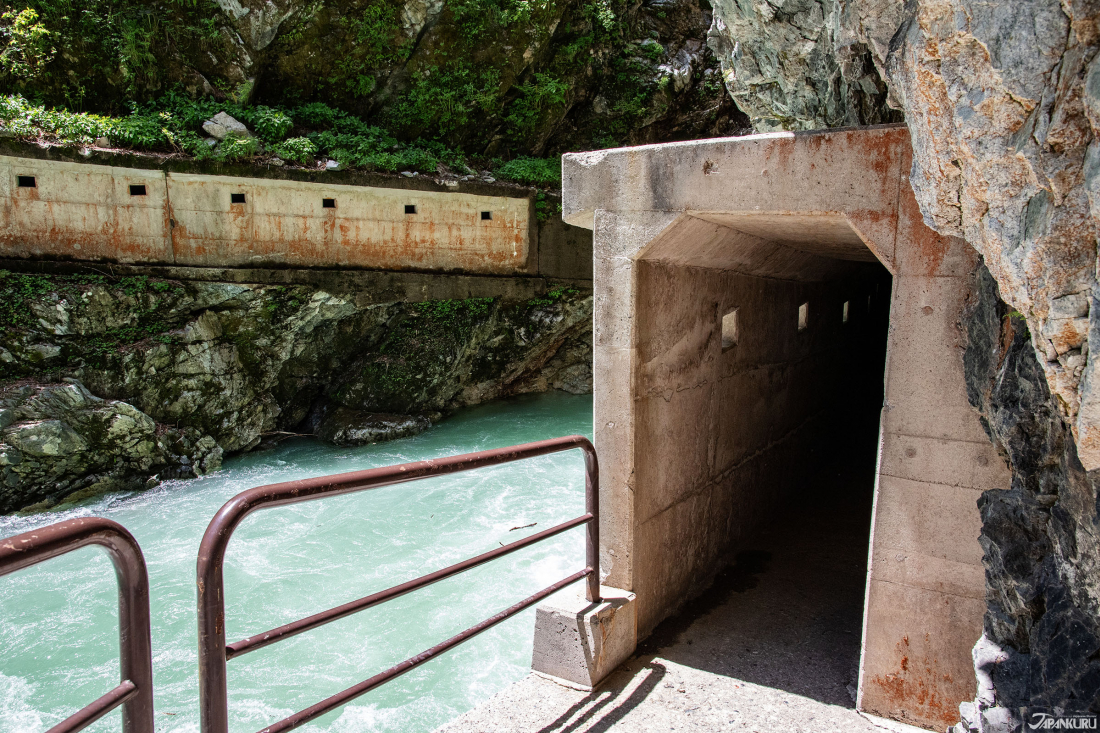
While riding the Torokko Train, you’ll probably notice a little tunnel following along the tracks. The train has long been used to get places that normal vehicles can’t, but that means that when winter rolls around and the train stops running, there’s no form of transportation in the area at all. Unfortunately for the maintenance workers doing their jobs at the gorge’s dams, that also cuts off standard deliveries of food supplies and newspapers.
During that part of the year, the delivery of necessary goods becomes the job of workers called “forwarders” (逓送さん). Even during the most relentless parts of winter, these forwarders hike through the tunnels all the way to their colleagues doing maintenance at the dams, carrying backpacks full of food and other supplies all the way there. Just one way, the trek takes about two hours! To this day, when winter comes, forwarders bring necessities on their own backs, hiking four hours round-trip. We have to say, thank you forwarders!
(The Torokko Train runs from April to November every year.)
Sightseeing in Kurobe: ④ Local Specialties for Foodies
When you visit Kurobe, don’t miss out on the seafood! The Kurobe region is right near Toyama Bay, where plankton is so abundant, you’ll find about 500 different kinds of fish in the area! There are also some varieties of seafood you’ll only find here, so you should definitely give them a taste.

Japanese Glass Shrimp (白エビ)
These shrimp can only be caught in Toyama Bay, which is why they’re sometimes called “The Treasure of Toyama.” When deep-fried, they make a satisfyingly crunchy snack that goes great with beer, but you can also find the small shrimp carefully peeled one by one, as delicately sweet and decadent sashimi.
Eating lunch at the Keyakidaira Station food court, we tried the glass shrimp curry. The shrimp lent the curry a lighter and more refreshing feeling than any hearty meat would have.

Firefly Squid
This variety of small squid can only be sampled in Hyogo or Toyama Prefectures, when in Japan. It can be prepared in lots of ways, including steamed, soy-pickled, stir-fried, and as sashimi. One of these dishes, firefly squid okizuke, is prepared by pickling the squid inside and out in a mix of sake and soy sauce. They say that if you try firefly squid okizuke on white rice, it’s so delicious you won’t need anything else to go with it! In addition, we recommend you try the much rarer dish of firefly squid shabu-shabu hotpot. You can find that particular entree at the ryokan we mentioned before, Unazuki Onsen Togen Ryokan.
⇩ How to enjoy firefly squid shabu-shabu. ⇩
Plan Your Unazuki Onsen Trip: Enjoy the Great Outdoors in Kurobe
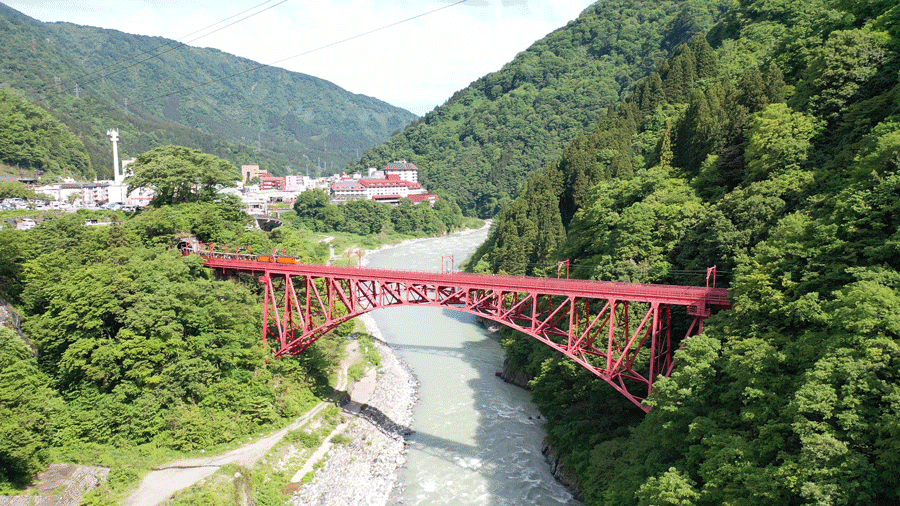
Also known as “Japan’s Northern Alps”, only in Toyama Prefecture will you find the Torokko Train, where you can tour the beautiful natural scenery of the gorge. It’s a place fun to travel with friends or family, a place where you’ll find views so beautiful that you never get tired of looking, delicious food made from local agricultural specialties, and dynamic activities.
If all this made you think you’d also like to enjoy Toyama to the fullest, why not try a trip to Kurobe’s Unazuki Onsen?
For more info and updates from Japan, check Japankuru for new articles, and don’t forget to follow us on X (Twitter), Instagram, and Facebook!
Details
NAME:Unazuki Onsen, Kurobe
MAP
ACCESS:Unazukionsen Station (宇奈月温泉駅)
COMMENT
FEATURED MEDIA
VIEW MORE 
A New Tokyo Animal Destination: Relax & Learn About the World’s Animals in Japan
#pr #japankuru #anitouch #anitouchtokyodome #capybara #capybaracafe #animalcafe #tokyotrip #japantrip #카피바라 #애니터치 #아이와가볼만한곳 #도쿄여행 #가족여행 #東京旅遊 #東京親子景點 #日本動物互動體驗 #水豚泡澡 #東京巨蛋城 #เที่ยวญี่ปุ่น2025 #ที่เที่ยวครอบครัว #สวนสัตว์ในร่ม #TokyoDomeCity #anitouchtokyodome

Shohei Ohtani Collab Developed Products & Other Japanese Drugstore Recommendations From Kowa
#pr #japankuru
#kowa #syncronkowa #japanshopping #preworkout #postworkout #tokyoshopping #japantrip #일본쇼핑 #일본이온음료 #오타니 #오타니쇼헤이 #코와 #興和 #日本必買 #日本旅遊 #運動補充能量 #運動飲品 #ช้อปปิ้งญี่ปุ่น #เครื่องดื่มออกกำลังกาย #นักกีฬา #ผลิตภัณฑ์ญี่ปุ่น #อาหารเสริมญี่ปุ่น

도쿄 근교 당일치기 여행 추천! 작은 에도라 불리는 ‘가와고에’
세이부 ‘가와고에 패스(디지털)’ 하나면 편리하게 이동 + 가성비까지 완벽하게! 필름카메라 감성 가득한 레트로 거리 길거리 먹방부터 귀여움 끝판왕 핫플&포토 스폿까지 총집합!
Looking for day trips from Tokyo? Try Kawagoe, AKA Little Edo!
Use the SEIBU KAWAGOE PASS (Digital) for easy, affordable transportation!
Check out the historic streets of Kawagoe for some great street food and plenty of picturesque retro photo ops.
#pr #japankuru #도쿄근교여행 #가와고에 #가와고에패스 #세이부패스 #기모노체험 #가와고에여행 #도쿄여행코스 #도쿄근교당일치기 #세이부가와고에패스
#tokyotrip #kawagoe #tokyodaytrip #seibukawagoepass #kimono #japantrip

Hirakata Park, Osaka: Enjoy the Classic Japanese Theme Park Experience!
#pr #japankuru #hirakatapark #amusementpark #japantrip #osakatrip #familytrip #rollercoaster #retrôvibes #枚方公園 #大阪旅遊 #關西私房景點 #日本親子旅行 #日本遊樂園 #木造雲霄飛車 #히라카타파크 #สวนสนุกฮิราคาตะพาร์ค

🍵Love Matcha? Upgrade Your Matcha Experience With Tsujiri!
・160년 전통 일본 말차 브랜드 츠지리에서 말차 덕후들이 픽한 인기템만 골라봤어요
・抹茶控的天堂!甜點、餅乾、飲品一次滿足,連伴手禮都幫你列好清單了
・ส่องมัทฉะสุดฮิต พร้อมพาเที่ยวร้านดังในอุจิ เกียวโต
#pr #japankuru #matcha #matchalover #uji #kyoto #japantrip #ujimatcha #matchalatte #matchasweets #tsujiri #말차 #말차덕후 #츠지리 #교토여행 #말차라떼 #辻利抹茶 #抹茶控 #日本抹茶 #宇治 #宇治抹茶 #日本伴手禮 #抹茶拿鐵 #抹茶甜點 #มัทฉะ #ของฝากญี่ปุ่น #ชาเขียวญี่ปุ่น #ซึจิริ #เกียวโต

・What Is Nenaito? And How Does This Sleep Care Supplement Work?
・你的睡眠保健品——認識「睡眠茶氨酸錠」
・수면 케어 서플리먼트 ‘네나이토’란?
・ผลิตภัณฑ์เสริมอาหารดูแลการนอน “Nenaito(ネナイト)” คืออะไร?
#pr #japankuru #sleepcare #japanshopping #nenaito #sleepsupplement #asahi #睡眠茶氨酸錠 #睡眠保健 #朝日 #l茶胺酸 #日本藥妝 #日本必買 #일본쇼핑 #수면 #건강하자 #네나이토 #일본영양제 #อาหารเสริมญี่ปุ่น #ช้อปปิ้งญี่ปุ่น #ร้านขายยาญี่ปุ่น #ดูแลตัวเองก่อนนอน #อาซาฮิ

Japanese Drugstore Must-Buys! Essential Items from Hisamitsu® Pharmaceutical
#PR #japankuru #hisamitsu #salonpas #feitas #hisamitsupharmaceutical #japanshopping #tokyoshopping #traveltips #japanhaul #japantrip #japantravel

Whether you grew up with Dragon Ball or you just fell in love with Dragon Ball DAIMA, you'll like the newest JINS collab. Shop this limited-edition Dragon Ball accessory collection to find some of the best Dragon Ball merchandise in Japan!
>> Find out more at Japankuru.com! (link in bio)
#japankuru #dragonball #dragonballdaima #animecollab #japanshopping #jins #japaneseglasses #japantravel #animemerch #pr

This month, Japankuru teamed up with @official_korekoko to invite three influencers (originally from Thailand, China, and Taiwan) on a trip to Yokohama. Check out the article (in Chinese) on Japankuru.com for all of their travel tips and photography hints - and look forward to more cool collaborations coming soon!
【橫濱夜散策 x 教你怎麼拍出網美照 📸✨】
每次來日本玩,是不是都會先找旅日網紅的推薦清單?
這次,我們邀請擁有日本豐富旅遊經驗的🇹🇭泰國、🇨🇳中國、🇹🇼台灣網紅,帶你走進夜晚的橫濱!從玩樂路線到拍照技巧,教你怎麼拍出最美的夜景照。那些熟悉的景點,換個視角說不定會有新發現~快跟他們一起出發吧!
#japankuru #橫濱紅磚倉庫 #汽車道 #中華街 #yokohama #japankuru #橫濱紅磚倉庫 #汽車道 #中華街 #yokohama #yokohamaredbrickwarehouse #yokohamachinatown

If you’re a fan of Vivienne Westwood's Japanese designs, and you’re looking forward to shopping in Harajuku this summer, we’ve got important news for you. Vivienne Westwood RED LABEL Laforet Harajuku is now closed for renovations - but the grand reopening is scheduled for July!
>> Find out more at Japankuru.com! (link in bio)
#japankuru #viviennewestwood #harajuku #omotesando #viviennewestwoodredlabel #viviennewestwoodjapan #비비안웨스트우드 #오모테산도 #하라주쿠 #日本購物 #薇薇安魏斯伍德 #日本時尚 #原宿 #表參道 #japantrip #japanshopping #pr

Ready to see TeamLab in Kyoto!? At TeamLab Biovortex Kyoto, the collective is taking their acclaimed immersive art and bringing it to Japan's ancient capital. We can't wait to see it for ourselves this autumn!
>> Find out more at Japankuru.com! (link in bio)
#japankuru #teamlab #teamlabbiovortex #kyoto #kyototrip #japantravel #artnews
Photos courtesy of teamLab, Exhibition view of teamLab Biovortex Kyoto, 2025, Kyoto ® teamLab, courtesy Pace Gallery

Japanese Makeup Shopping • A Trip to Kamakura & Enoshima With Canmake’s Cool-Toned Summer Makeup
#pr #canmake #enoshima #enoden #에노시마 #캔메이크 #japanesemakeup #japanesecosmetics

⚔️The Robot Restaurant is gone, but the Samurai Restaurant is here to take its place. Check it out, and don't forget your coupon!
🍣신주쿠의 명소 로봇 레스토랑이 사무라이 레스토랑으로 부활! 절찬 쿠폰 발급중
💃18歲以上才能入場的歌舞秀,和你想的不一樣!拿好優惠券去看看~
#tokyo #shinjuku #samurairestaurant #robotrestaurant #tokyotrip #도쿄여행 #신주쿠 #사무라이레스토랑 #이색체험 #할인이벤트 #歌舞伎町 #東京景點 #武士餐廳 #日本表演 #日本文化體驗 #japankuru #japantrip #japantravel #japanlovers #japan_of_insta

Japanese appliance & electronics shopping with our KOJIMA x BicCamera coupon!
用JAPANKURU的KOJIMA x BicCamera優惠券買這些正好❤️
코지마 x 빅 카메라 쿠폰으로 일본 가전 제품 쇼핑하기
#pr #japankuru #japanshopping #kojima #biccamera #japaneseskincare #yaman #dji #osmopocket3 #skincaredevice #日本購物 #美容儀 #相機 #雅萌 #日本家電 #일본여행 #면세 #여행꿀팁 #일본쇼핑리스트 #쿠폰 #일본쇼핑 #일본브랜드 #할인 #코지마 #빅카메라 #japankurucoupon











































